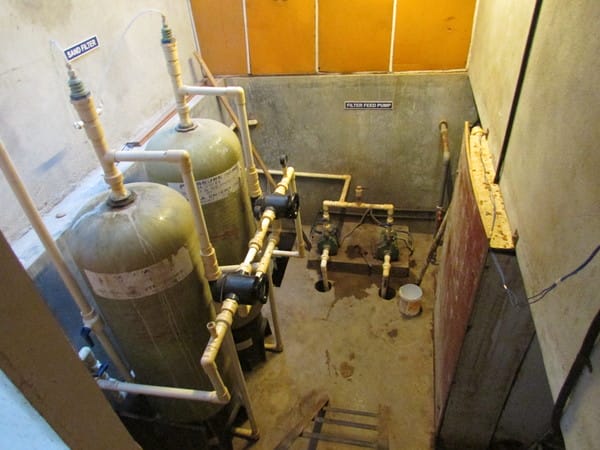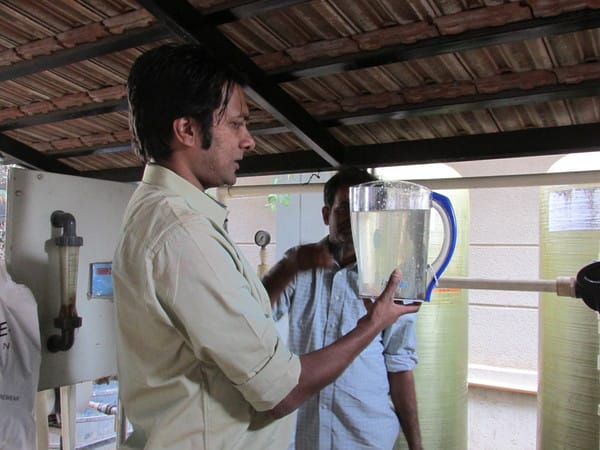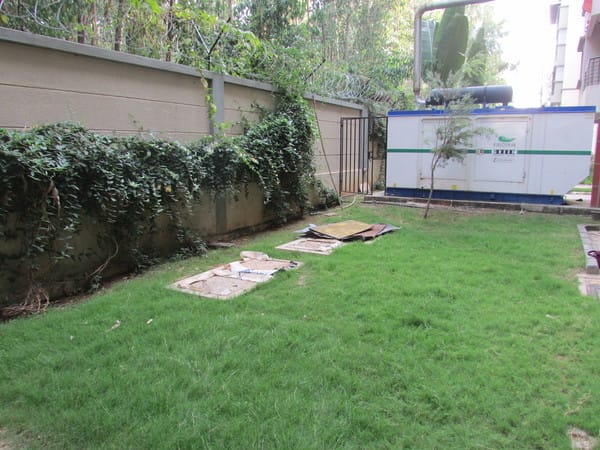The fully functional water treatment system. Pic: Akshatha M
Arjun Ravi Kumar, a builder, once visited T-Zed, an apartment-cum-villa community that treats and reuses all its waste water. There he met Srinivasan Sekar, who as part of the Management Committee there, worked on the water system design. He recalls, “Sekhar offered me a glass of tap water saying that it is generated from sewage, initially I was a bit reluctant to drink it but when I did, (I realised) it was as good as any bottled water. “
Arjun lives in an apartment that his firm built – Surbacon Maple, off Sarjapur Road, where he uses recycled water for nonpotable purposes. Surbacon Maple, built in 2013-14 is one of the few apartments that seems to have designed its water system for the future. It has a dual plumbing provision for treated wastewater to be used in common areas, including gardening the lawns and washing cars. “We do not buy water for external uses,” Arjun says. Residents of Surbacon Maple are able to save up to Rs 20,000 a month.
Inspired by the T-Zed approach, Arjun’s team designed a future safe water system. “We felt that as water prices go up in the future, people may become more willing to use recycled water so we spent an additional Rs 8-10 lakhs to set up the water treatment and purification system,” explains Arjun.
However, since some residents are unwilling to use treated water for their personal and household needs, the RO system that can make the treated water potable remains unused. Arjun says the RO water that the generate is of better quality than the water that they get through tankers and they can drink it but “because that water comes from sewage it’s a tough pill to swallow (for residents)”.
“If the RO system is fully utilised, our water consumption from outside sources would come down by half,” he calculates. The apartment is currently buying tanker water for household use. “Now with a water committee (in place), we can start using recycled water even for indoor purposes in the future,” he hopes.
With a growth rate of almost 47 per cent and increased demand for water, water recycling and reuse seems to be a viable option in addition to rainwater harvesting (RWH) for Bengaluru in the long run. However, a psychological barrier seems to prevent Bengalureans from using recycled water and a lack of awareness preventing a large scale implementation of RWH in the city.
Rainwater and treated water if used for domestic purposes can become an important water source for the city with a capacity to supply over 1400 MLD, equivalent to what is being pumped from the Cauvery.
The Bangalore Water Supply and Sewerage Board (BWSSB) has made the setting up of both rain water harvesting structures and sewage treatment plants (STPs) mandatory in all larger complexes across the city. However, the establishment of such structures in apartments that were built before the issuance of the gazette is not happening at the required pace and apartments that have STPs are mostly using it to just treat the water before it flows out into the drain.
S Vishwanath, water expert points out, “Whatever water the city consumes, about 80 per cent of it goes out as wastewater. The wastewater can be treated, moderated through constructed wetlands filled into lakes, which again recharges the aquifer and then can be brought back to the drinking water supply. So in theory if we implement projects there should never be a shortage of water in the city.”
Arjun Ravi Kumar who built Surbacon Maple shows the treated water (not RO treated) in the water treatment plant. Pic: Akshatha M
Unwilling to drink treated water
Priya R, a resident of another apartment on Sarjapur Road says she will not drink water that is sourced from garbage and human excreta, even if it goes through an Reverse Osmosis (RO) purification process.
“I don’t drink recycled water. However, we have a dual plumbing system connected to a sewage treatment plant (STP) where water is recycled and reused for outdoor purposes like watering plants or washing cars. We use tanker water inside the households,” she says. Like her several apartment residents around the city prefer using recycled water or rainwater for external purposes and rely on private water suppliers for drinking water.
Arjun Ravi Kumar says that in spite of having functional STPs in larger complexes after the government mandate, several builders do not take up the extra investment of dual plumbing that could bring back the treated water flow into the apartments supply system.
A pioneer in waste water reuse
T-Zed, a group of 94 houses, villas and apartments, in Whitefield was the first community to initiate comprehensive water recycling and reuse in 2012. Srinivasan Sekhar and his fellow Management Committee members decided to connect their existing STP system with the RO purifiers, that was up till then being used to purify tanker water and conducted blind testing to convince residents on the quality of the recycled wastewater.
Sekhar explains that the housing complex uses a three phase purification system with two RO cylinders and ozonizer that purifies the treated water coming from the apartments’ STP and makes it completely potable. “The water is completely drinkable and over 90 households have been using it for the last four years. It took some time to convince the residents, but once they saw that there was no difference between the tanker water that they were previously buying and the treated wastewater, they started using it for all their daily requirements.” The MC team held several awareness and water testing sessions before being able to convince all the residents on using their treated wastewater for potable purposes.
“T-Zed is probably the first community in all of India that are actually drinking their own treated wastewater,” says Vishwanath.
Underground used water collection and treatment system at Surbacon Maple apartment off Sarjapur Road. Pic: Akshatha M
Resolving the mental blockade
Sekar, now a green entrepreneur, designed the STP with RO system in Surbacon Maple. “It is the lack of knowledge and information that people are reluctant to use recycled water. The solution is in a full product campaigning. Engineering (setting up of STPs) is only half the solution. The second half of the solution which is more important is educating and convincing the users,” says Sekhar.
Vishwanath agrees, “that (the reluctance to use recycled water) is a complete ignorance about the quality of rainwater and wastewater. That ignorance has to be removed through water literacy.” He says there is a need for scale up initiativesto promote rainwater harvesting, the conservation of lakes and to promote the reuse of waste-water in partnership with the government. He points out, “Bengaluru is the (one) city which shows the most pioneering ability for citizen groups to consolidate and engage with the government for solutions.”
Can Bengaluru show the way? Will the dwindling water supply make this inevitable?
Related Articles
BWSSB STP rules: Creating more problems than solutions
BWSSB mandates smart sensors for treated sewage, backtracks within a month
STP mess partly due to our lack of clarity: KSPCB chief


